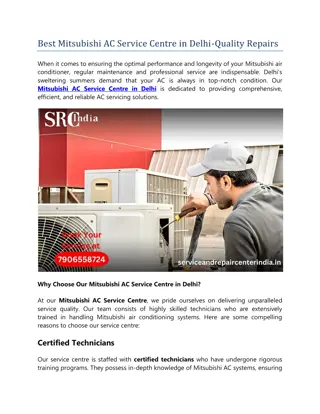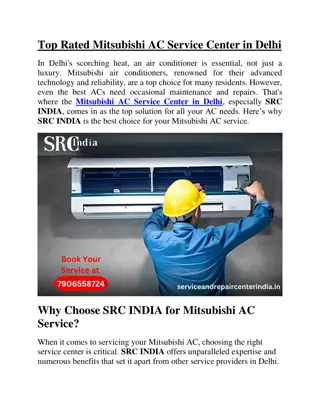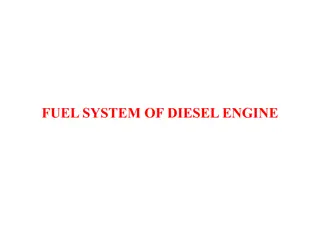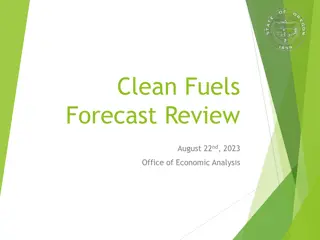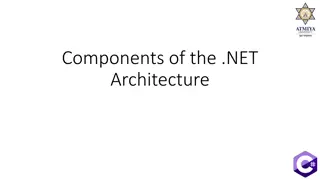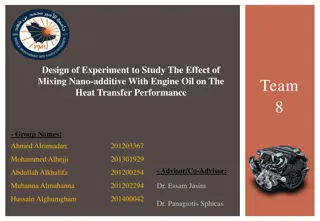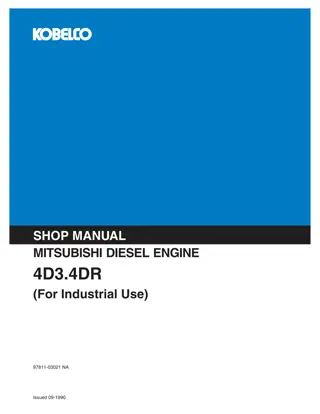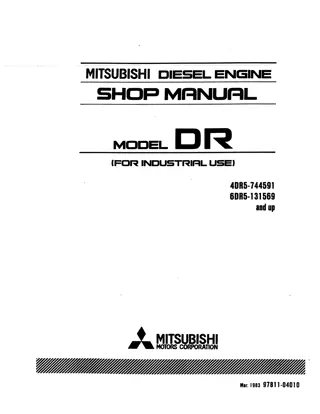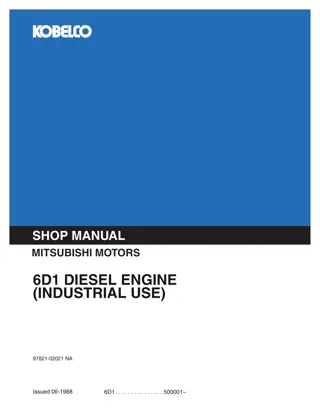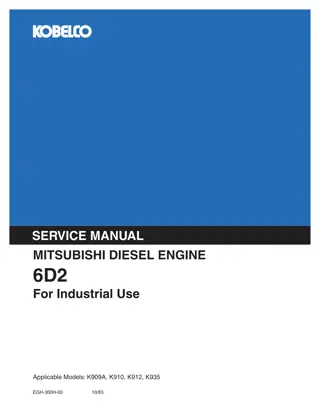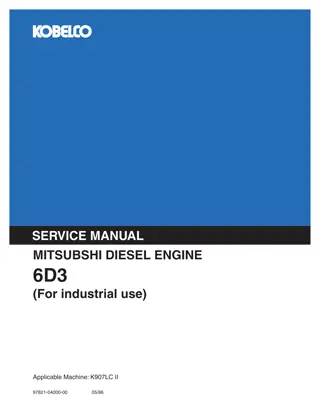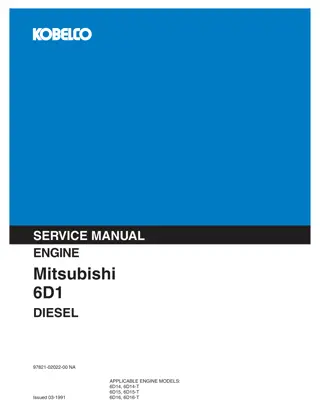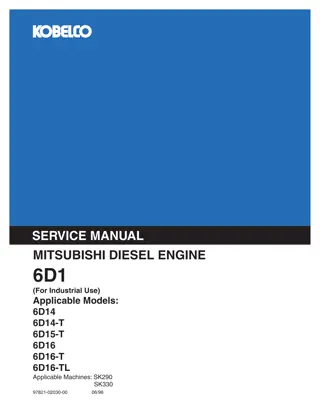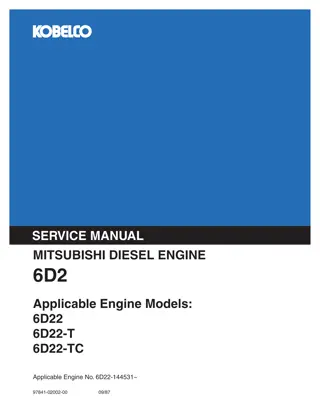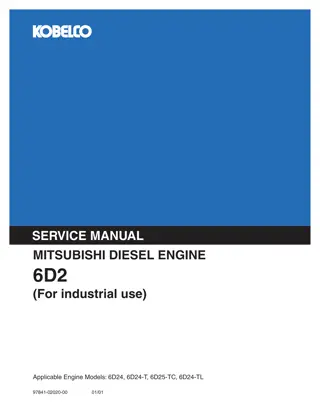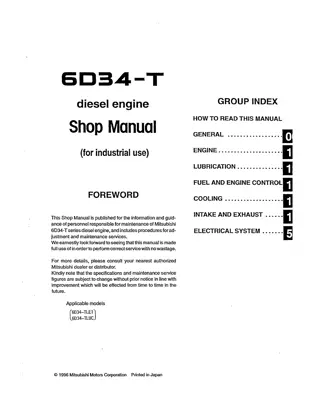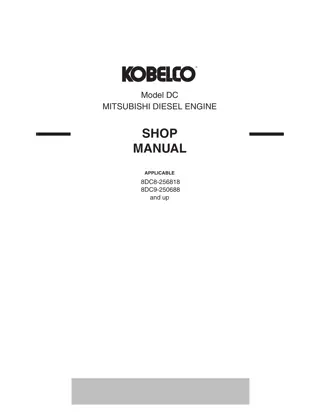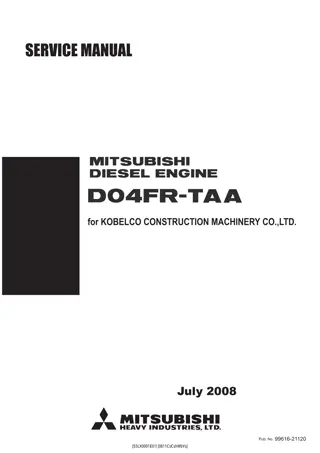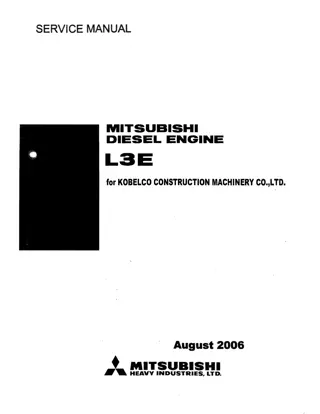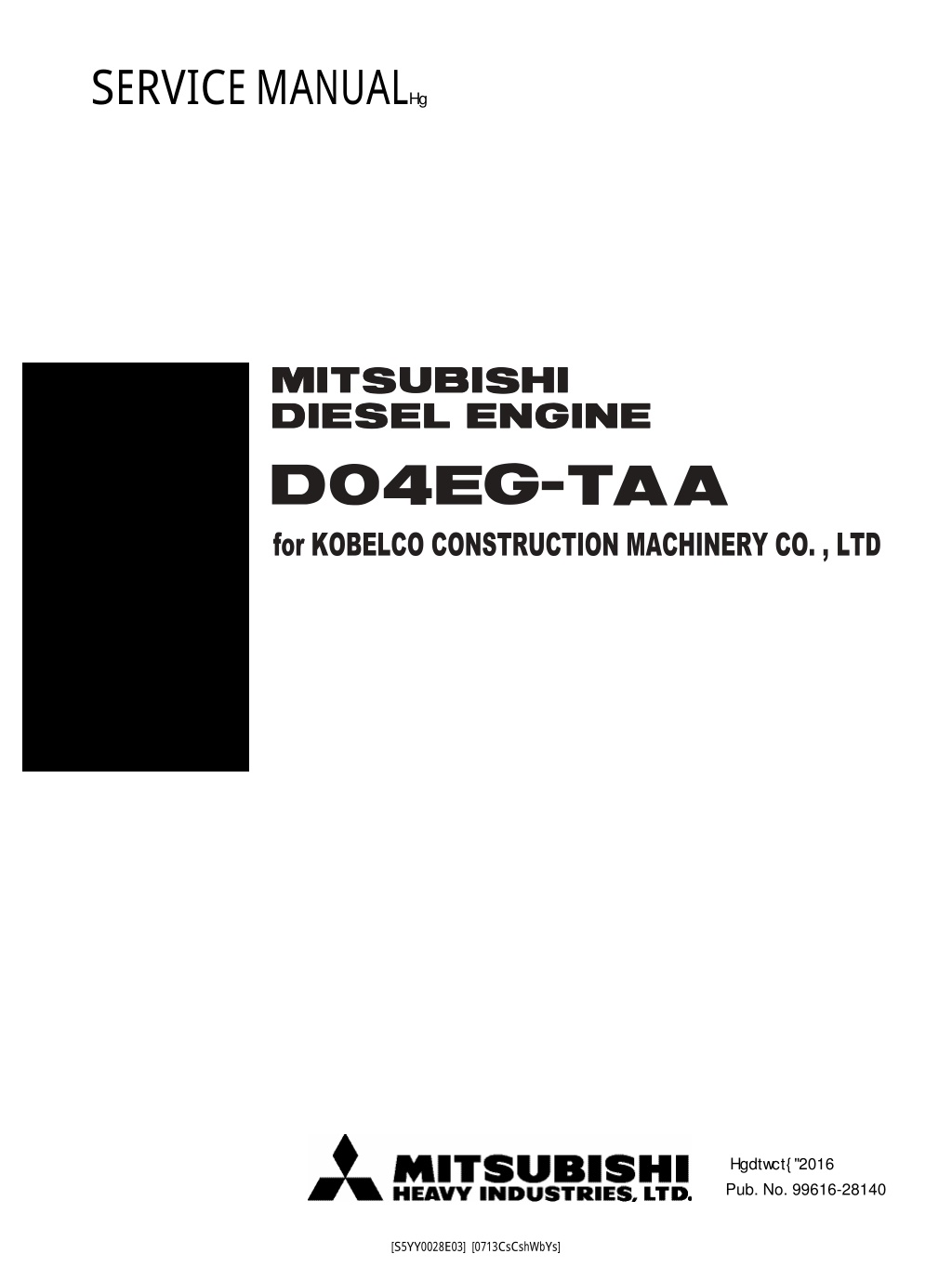
Kobelco Mitsubishi D04EG-TAA DIESEL ENGINE Service Repair Manual Instant Download (Book Code No. 99616-28120)
Please open the website below to get the complete manualnn//
Download Presentation

Please find below an Image/Link to download the presentation.
The content on the website is provided AS IS for your information and personal use only. It may not be sold, licensed, or shared on other websites without obtaining consent from the author. Download presentation by click this link. If you encounter any issues during the download, it is possible that the publisher has removed the file from their server.
E N D
Presentation Transcript
SERVICE MANUAL ?? 1COVER for KOBELCO CONSTRUCTION MACHINERY CO. , LTD ?????????201? Pub. No. 99616-281?0 [S5YY0028E03] [0713CsCshWbYs]
Foreword This service manual describes the maintenance and adjustment procedures, and specifi- cations for Mitsubishi diesel engines. To maintain the performance of the engine for many years and to ensure safe operation, it is important to use the engine correctly and conduct scheduled inspection and mainte- nance, and it may also be necessary to take appropriate measures which involve in disas- sembly, inspection, repair and assembly work of the engine and engine parts. Read through this manual carefully and understand the work procedures fully before dis- assembling, inspecting, repairing or assembling the engine. The contents of this manual are based on the engine model produced at the time of publi- cation. Please note that the contents of this manual may change due to improvements made thereafter. I [S5YY0028E03] [0713CsCshWbYs]
Foreword HOW TO USE THIS MANUAL This service manual consists of several chapters, which will give you quick references to specifications, maintenance standards, adjustment and service procedures including practices to disassemble, inspect, repair and assemble the Mitsubishi diesel engines. A short summary describing the contents of each chapter is given in the CHAPTER INDEX page, and there is also a detailed table of contents at the beginning of each chapter. Regarding the procedures for operation and scheduled maintenance of the engine, refer to the Operation and Maintenance Man- ual. For information on the engine components and ordering of service parts, refer to the Parts Catalogue. Structure and func- tion of the engine are described in the relevant training manuals. If you have an inquiry, please check the engine model and serial number, and contact our service department. Description format (1) Index numbers allotted to parts in exploded views are not only a call-out of part names listed in the text but also an indica- tion of the sequence of disassembly. (2) Inspections to be conducted during disassembly process are indicated in boxes in the relevant exploded views. (3) Maintenance standards required for inspection and repair works are indicated in the appropriate positions in the text. They are also collectively indicated in the Chapter 2. (4) The tightening torque with engine oil applied on the thread, is specified [Wet]. Unless otherwise specified, the tightening torque is of dry condition. (5) In this manual, important safety or other cautionary instructions are emphasized with the following head marks. Indicates an immediately hazardous situation which, if not avoided, will result in death or serious injury. Indicates a potentially hazardous situation which, if not avoided, could result in death or serious injury. Indicates a potentially hazardous situation which, if not avoided, may result in minor or moderate injury. Indicates a potentially hazardous situation which, if not avoided, may result in property damage. Emphasizes important matter, or indicates information useful for operation or maintenance of the engine. Note II [S5YY0028E03] [0713CsCshWbYs]
https://www.ebooklibonline.com Hello dear friend! Thank you very much for reading. Enter the link into your browser. The full manual is available for immediate download. https://www.ebooklibonline.com
Foreword Terms used in this manual Nominal value means the basic nominal size of a part to be measured. Standard value means the quantitative requirement for dimension of a part, clearance between parts and performance. The values are rounded off for the inspection job, and do not necessarily conform to the design values. Limit value means the value, which the measured value reaches, the part needs repair or replacement with a new one. Abbreviations and Standards BTDC : Before Top Dead Center ATDC : After Top Dead Center BBDC : Before Bottom Dead Center ABDC : After Bottom Dead Center TIR : Total Indicator Reading API : American Petroleum Institute ASTM : American Society for Testing and Materials JIS : Japanese Industrial Standards LLC : Long Life Coolant MIL : Military Specifications and Standards (U.S.A.) MSDS : Material Safety Data Sheet SAE : Society of Automotive Engineers (U.S.A.) P/N : Part Number Unit of Measurement Measurements are based on the International System of Units (SI), and their converted metric values are indicated in { } and U.S. customary values are in [ ]. For the conversion, the following rates are used. Pressure :1 MPa = 10.197 kgf/cm2 Torque :1 N m = 0.10197 kgf m Force :1 N = 0.10197 kgf Output power :1 kW = 1.341 HP = 1.3596 PS Pressure (mercury column) :1 kPa = 0.7 cmHg Pressure (water column) :1 kPa = 10.197 cmH2O (cmAq) Rotation speed:1 min-1 = 1 rpm III [S5YY0028E03] [0713CsCshWbYs]
Foreword Safety Cautions Fire and Explosion Precautions Pay Attention to Fuel, Oil and Exhaust Gas Leak Keep Flames Away Do not use flames near the engine (in the engine room). The flame is dan- If any fuel, oil or exhaust gas leakage is found, imme- gerous to ignite combustibles and diately take corrective measures to stop it. Such leak- cause a fire. Wipe off spilled fuel, oil ages, if left uncorrected, can cause fuel or engine oil to and LLC immediately and thoroughly. reach hot engine surfaces or hot exhaust gas to con- Spilled fuel, oil and LLC may ignite and cause a fire. tact flammable material, may results in a fire, personal Store the fuel and engine oil in a well ventilated area. injury and damage to the equipment. Make sure that the fuel and engine oil container caps Use Explosion-Proof Light are tightly fastened. When inspecting fuel, engine oil, coolant, battery elec- Tidy up Around the Engine trolyte, etc., use an explosion-proof light. If the lighting Do not place combustible or explosive material, such is not an explosion-proof type, it may ignite and cause as fuel, engine oil, LLC or explosive powder near the an explosion. engine. Such substances can cause a fire or explo- Prevent Electrical Wires from Short Circuit sion. Thoroughly remove dust, dirt and other foreign Avoid inspecting or servicing the electrical system with material collected on the engine and the area around the battery cable connected to the battery. Otherwise, the engine. Such material can cause a fire or the a fire could result from short circuit. Be sure to discon- engine to overheat. In particular, clean the top surface nect the battery cable from the negative (-) terminal of the battery thoroughly. Dust can cause a short cir- before starting work. A loose terminal and a damaged cuit. Always place the engine at a position at least 1 m cable or wire may result in a short circuit and a fire. [3.28 ft.] apart from buildings and other equipment to Inspect, and if any defect is found, repair or replace it prevent a possible fire caused by engine heat. before starting work. Keep Fire Extinguishers and First-Aid Kit Handy Keep fire extinguishers handy, and become familiar with their usage. Keep a first-aid kit at the designated place to be ready for use in an emer- gency. Make counteract procedures against a fire or an accident. Provide the contact per- son and means of communication in case of emer- gency. IV [S5YY0028E03] [0713CsCshWbYs]
Foreword Stay Away From Rotating and Moving Parts Lockout and Tagout Install Protective Covers Over Rotating Parts After Inspection and Maintenance Work Be sure to lockout and tagout before starting inspec- tion and maintenance. Lockout and tagout are effec- tive methods of cutting off machines and equipment Check the covers over engine rotating from energy sources. To accomplish the lockout/ parts for correct installation. Repair tagout, remove the starter switch key, set the battery any damaged or loosed covers. Never switch to OFF position and attach a DO NOT RUN or remove the protective covers over equivalent caution tag to the starter switch. The starter rotating parts during operation. When switch key must be kept by the person who performs the engine is coupled to a radiator or other equipment, inspection and maintenance work. install protective covers over the exposed connecting Be Sure to Stop the Engine Before Inspec- tion and Maintenance belt and coupling. Check Work Area for Safety Before Starting Be sure to stop the engine before proceeding to Before starting the engine, make sure that no one is inspection and maintenance work. Never try to make near the engine and that tools are not left on or near adjustments on the engine parts while the engine is the engine. Verbally notify persons within the immedi- running. Rotating parts such as belt can reel in your ate area when starting the engine. When the starter body and cause serious injuries. device is tagged with the warning sign saying DO NOT Always Put Back Engine Turning Tool After Use RUN, never start the engine. Stay Away From Moving Parts While Engine Operates Be sure to remove the turning tool used for inspection and maintenance work. If the engine is started with a Keep away from the rotating parts turning tool inserted, it can not only cause a damage to during operation. Do not leave any the engine, but also lead to a personal injury. objects that may get caught in rotating parts. If clothes or a tool gets caught in rotating parts, serious injury will result. V [S5YY0028E03] [0713CsCshWbYs]
Foreword Be Careful of Falling Be Careful of Exhaust Gas Poison- ing Lift Engine Carefully Be Careful of Ventilation to Operate Engine Use slings or wire ropes strong enough to lift the load considering the If the engine is installed in an engine weight. To lift the engine, hitch enclosed area, and the exhaust gas is the proper slings to the lifting hangers ducted outside, make sure that duct prepared on the engine. To lift the joints are free from gas leak. Exhaust engine, keep the engine in a well-bal- gas from the engine sometimes con- anced position, thinking carefully of the engine center tains harmful components. Operating the engine in an of gravity. ill-ventilated area can cause gas poisoning. Be Careful of Hearing Loss The hangers prepared on the engine are designed for lifting the weight of engine only. In the case where the generator, marine gear, and others are installed to the Wear Ear Plugs engine, consider that the additional weight will not Wear ear plugs to check the engine affect the hangers of the engine. room while the engine is running. Keep the angle formed by slings attached to hangers Combustion sound and mechanical within 60 . If the angle exceeds this limit, excessive noise of engine can cause hearing load may be applied to the hangers and damage the loss. hangers. If the wire rope contacts the engine directly, place a cloth or other soft pad to avoid damage to the engine and wire rope. Remove the engine part if nec- essary. Do not Climb Onto the Engine Do not climb onto the engine, nor step on any engine parts on the engine sides. To work on parts located high on the engine, use a ladder, footing, and others to prevent from slipping and falling. Climbing onto the engine may result in engine part damage and your injury by falling down. Always Prepare a Stable Footing When working on the upper part of the engine and other hard-to-reach places, use a stable footing. Stand- ing on an old footstool or parts box may result in personal injury. Do not put any unnecessary objects on a footing. VI [S5YY0028E03] [0713CsCshWbYs]
Foreword Be Careful of Burns Be Careful When Handling Fuel, Engine Oil or Coolant Do Not Touch the Engine During or Immedi- ately After Operation Use Specified Fuel, Engine Oil and Coolant Only Do not touch any parts of the engine and exhaust system (especially DPF Use the fuel, oil and coolant specified in this manual system) during or immediately after only, and handle them carefully. Use of material other the operation. You can get burned. than specified one, or improper handling may cause Before starting the maintenance and inspection work, various engine defects and malfunctions. Get the check the water temperature meter to make sure that MSDS issued from the fuel, oil and coolant suppliers, the engine is cooled down. and follow the directions in the MSDS for proper han- dling. Be Careful to Open and Close the Radiator Cap Be Careful with Coolant When handling coolant, wear rubber gloves and a pro- Never open the radiator cap while the engine is run- tective face mask. If the coolant contacts your skin, or ning or immediately after the engine stops. Stop the get into your eyes or mouth, it may cause injury of skin engine and give a sufficient time to allow the coolant to or eyes, or poisoning. If coolant is accidentally swal- cool down before opening the cap. When opening the lowed, induce vomiting immediately and seek medical radiator cap, slowly open the cap so as to release attention. If coolant enters your eyes, flush them internal pressure. To prevent hot steam scalds, wear immediately with plenty of water and seek medical thick rubber gloves, or cover the cap with a cloth. attention. If coolant contacts your skin or clothing, When closing the radiator cap, tightly close the cap. wash it away immediately with plenty of water. Keep Do not open the radiator cap during engine running or flames away from coolant. Coolant can catch flames immediately after engine stop. Otherwise hot steam and cause a fire. Drained coolant is a hazardous mate- and coolant gush out and can cause burns. rial. Do not discard it in an unauthorized procedure. Refill Coolant Only After the Coolant Tem- perature Dropped Practice the applicable law and regulations when dis- card drained coolant. Refill the coolant after the coolant temperature drops Proper Procedure to Discard Waste Oil and Coolant to a room temperature. Replacement job immediately after the engine stop may cause burns. Do not discard waste engine oil or coolant in an unau- thorized procedure. Such a way of disposal is strictly prohibited by laws and regulations. Discard waste oil, coolant and other environmentally hazardous waste in accordance with the applicable laws and regulations. VII [S5YY0028E03] [0713CsCshWbYs]
Foreword When Abnormality Occurs Battery Stop Overheated Engine After Cooling Run Be Careful with Battery Even if the engine is about to overheat, do not stop the Never use flames or generate sparks near the battery. The bat- tery gives off highly flammable hydrogen gas and oxygen gas. Any flame or spark near a battery may cause an explosion. Do not use the battery if its fluid level is below the lower limit line. Wrong use of the battery may result in an explosion. Do not short the battery terminals with a tool or other metal object. When disconnecting battery cables, always remove first from negative (-) terminal first. When reconnect- ing the cables, always connect first to the positive (+) terminal. Charge the battery in a well-ventilated area, with all battery cables removed. Make sure the cable clamps are securely fastened to the battery terminals. A loose terminal can cause sparks that may result in an explosion. Before servicing electrical components or conducting electric welding, set the battery switch to the [Open/ OFF] position or disconnect the cable from the nega- tive (-) battery terminal to cut off the electrical cur- rent. Electrolyte (battery fluid) contains dilute sulfuric acid. Careless handling of the battery may lead to the loss of sight and/or skin burns. Also, do not swallow bat- tery fluid. Wear protective goggles and rubber gloves when working with the battery (such as adding water or charging). If battery electrolyte is spilled onto the skin or cloth- ing, immediately wash it away with lots of water. Use soap to clean thoroughly. Battery fluid can make you blind if splash into your eyes. Immediately flush it away with plenty of clean water, and seek immediate medical attention. If battery fluid is accidentally swallowed, gargle with plenty of water, then drink lots of water, and seek immediate medical attention. engine immediately. Abrupt stopping of an overheated engine can cause the coolant temperature to rise, resulting in seized engine parts. If the engine is about to overheat, run the engine at low idling speed (cooling operation), and stop the engine after the coolant tem- perature lowers sufficiently. Do Not Add Coolant Immediately After a Sudden Stop Due to Overheating. If the engine stops suddenly due to overheating, or you suddenly stop the engine by any reason, do not add coolant immediately. If coolant is added immedi- ately, parts such as cylinder heads can be damaged due to the sudden drop of temperature. Add coolant slowly after the engine becomes cool. Be Careful to Restart After an Abnormal Stop If the engine stops abnormally, do not restart the engine immediately after the stopping. If the engine stops or is stopped, inspect the engine to clarify the cause of the defect and correct the cause before restarting. If the engine is kept operating in such a condition, it can result in serious engine failure. Immediately Stop the Engine When Engine Oil Pressure Drops. If the engine oil pressure drops significantly, stop the engine immediately, and inspect the lubrication sys- tem to find the cause. Continuous engine operation with low oil pressure may cause bearings and other parts to seize. Stop the Engine Immediately When the Belt Break If the belt breaks, stop the engine immediately. Contin- uous engine operation with the broken belt can cause the engine to overheat. Steam of boiled coolant may gush out from the reserve tank or radiator, and results in burns. VIII [S5YY0028E03] [0713CsCshWbYs]
Foreword Other Cautions Do Not Operate the Engine in an Over- loaded Condition Do Not Tamper If tampered, the warranty is totally void even in the warranty period. Tampering with the engine can not If the engine shows an overloaded condition such as only damage the engine but also may lead to personal black exhaust smoke, reduce the load immediately to injury. an appropriate load condition. Overloading causes not only high fuel consumption but also excessive carbon Perform All Specified Pre-operation Inspec- tions and Scheduled Inspections deposits inside the engine. Carbon deposits cause various problems and will shorten the service life of the Conduct the daily inspection and scheduled inspec- engine. tion/maintenance as described in this manual. Cool Down the Engine Before Stop Failure to conduct the specified inspections may cause Cool down the engine at a low idling for five to six min- various engine problems, damage to parts, and a seri- utes before stopping it. Stopping the engine immedi- ous accident. ately after high-load operation will cause local heat up Wear Proper Work Clothing and Protective Gears of engine parts and shorten the service life of the engine. During the cooling operation, check the engine Wear a hard hat, face shield, safety shoes, dust mask, for abnormalities. gloves, ear plugs, and other protective gears as Do Not Continue Low Load Operation needed. When using compressed air, wear ear plugs, Low load continuous operation (less than 30%) must safety goggles, a hard hat, gloves, and other neces- be limited within one hour. Long warm-up operation sary protective gears. Works without wearing proper causes carbon deposits in the cylinders, and may lead protective gears may result in serious injury. to incomplete combustion. Also, after low load opera- Break-in the Engine tion for approx. one hour, run the engine at a 30% or To break-in a new engine or overhauled engine, oper- higher load for five minutes or more. ate the engine at a speed lower than the rated speed Avoid continuous low-idling operation as it may cause in a light load condition during the first 50 hours of the soot accumulation in the DPF, and shorten the operation. Operating a new engine or overhauled manual regeneration interval. Also, conduct the man- engine in a severe condition during the break-in period ual regeneration immediately after the (vehicle moni- shortens the service life of the engine. tor) alarm expediting the manual regeneration is Warm-up the Engine Before Use activated. After starting the engine, run the engine at a low idling Use Care to Protect Engine from Water speed for warming-up, Start the work after the coolant Use care to protect engine from water such as rain temperature is raised. Warm-up operation circulates entering through the air inlet or exhaust openings. Do lubricant in the engine, and works for the longer ser- not wash the engine while it is running. Cleaning fluid vice life and economical operation. Do not continue or water can be sucked into the engine. Starting the the warm-up operation for a longer time than neces- engine with water inside the combustion chambers sary. Carbon build-up in the cylinders and incomplete can cause the water hammering, and may result in combustion may result. Sometimes, white smoke may engine inner parts damage and serious accident. Do exhausted when the engine speed and load are not use a high-pressure or hoe washing. Water will increased after a prolonge time warming-up operation. enter the sensor or harness, and a serious accident This is not a trouble. may be the result. IX [S5YY0028E03] [0713CsCshWbYs]
Foreword Do Not Turn Off the Battery Switch During Operation Properly Maintain the Air Cleaner The major cause of abnormal wear on engine parts is foreign materials from intake air. Worn parts produce Do not turn off the battery switch during operation. If many problems such as increase of oil consumption, the battery switch is turned OFF when the engine is decrease of output and starting difficulties. For effec- running, not only various indicators will stop working tive removal of dust from intake air, maintain the air but also the diodes and transistors in the starter can cleaner according to the following instructions. be damaged. Do not maintain the air cleaner during operation. For- eign material enters the engine and may result in a serious failure. Remove the air cleaner slowly to prevent dust accu- mulated on the element from falling off. After remov- ing the air cleaner, immediately cover the opening (inlet port of air cleaner) with plastic sheet or similar means to prevent dust from entering the engine. An air cleaner with a dust indicator gives an alarm when it is clogged. Conduct maintenance when the alarm is given. Cautions for Engine Transportation To road-transport the engine, consider the engine weight, width and height, and obey applicable laws and regulations such as road traffic laws, vehicle road acts and vehicle restriction ordinances. Be Careful of Engine Room Ventilation Always keep the engine room well-ventilated. Insuffi- cient intake air amount of the engine can cause an increase in the engine temperature, and could result in a decrease in the output power and poor performance. Observe Safety Rules at Work Site It is highly recommended to calculate the required Observe the safety rules established at the workplace amount of air supply to the engine and install an ade- when operating and maintaining the engine. Do not quate ventilation system before installing the engine. operate the engine if you are in bad health. Consult Do Not Touch High Pressure Fuel Jet. your supervisor about your condition. Operation of the Do not touch fuel jet leaked or sprayed from the high engine with decreased attention may cause improper pressure injection pipe. Fuel in the fuel injection pipe operation and results in an accident. When working in has a high pressure and if the fuel impinges your skin, a team of two or more people, use specified hand sig- it goes through the skin and can cause serious injury. nals to communicate among workers. Use Proper Tools for Maintenance Work Always keep in mind to select most appropriate tools for the work and use them correctly. If a tool is dam- aged, replace with new tool. Do Not Operate Starter for a Long Time Do not use the starter for more than 10 seconds at a time. If the engine does not start, wait for at least 1 minute before starting again. Continuous operation of the starter to start a stubborn engine may lead to a flat battery or starter burning out. X [S5YY0028E03] [0713CsCshWbYs]
?Foreword Warning Labels Maintenance of Warning Labels Make sure all warning/caution labels are legible. Clean or replace the warning or caution label when the description or illustration is not clear to read. For cleaning the warning/caution labels, use a cloth, water and soap. Do not use cleaning solvent, gasoline or other chemicals to prevent the label from fading and peering. Replace a damaged or missing label with a new one. If any engine part stuck with a warning label is replaced with a new one, attach a new identical warning label to the new part. To get new warning labels, contact our approved dealer. THERE IS FEAR OF A FIRE. PLEASE DO NOT BRING FIRE CLOSE. PROHIBITION 45A93-51700 Warning Labels XI [S5YY0028E03] [0713CsCshWbYs]
Foreword Points on Assembling Wash all engine parts, except such parts as oil seals, O- rings and rubber seats, in cleaning oil and dry them with compressed air. Use correct tools and instruments. Use only high-quality lubricating oil and grease of the appropriate type. Be sure to apply oil, grease or adhesive to specified surfaces. Use a torque wrench to tighten parts correctly when their tightening torques are specified. Refer to "Tightening torque table." Replace Gaskets, packings and O-rings with new ones. Use protective gloves when you touch overheated or fro- zen parts. Touching the part with a bear hand can cause burns. Points on Disassembling and As- sembling This service manual contains the recommended practices to service the engine. The manual also contains dedicated spe- cial tools made for the work, and the basic safety cautions to obey when working. Note that this manual does not cover all potential hazards that could occur during maintenance, inspection and service works of the engine. When working on the engine, follow the related instructions in this manual and also be careful of the following: Points on Disassembling Use correct tools and instruments. Or serious damage or accident may result. Do not use jack bolts having sharp edge, as they may cause damage to the surface. Use a footing and workbench to place disassembled parts if necessary, and obey the disassembling procedures described in this manual. Do not place the parts on the floor directly. Place them on a workbench or the like. Place the engine parts in the order of removal to prevent from missing. Place the parts in the serial order for reas- sembling. When reusing the engine parts, unless there are special rea- sons, install them to their original positions. Pay attention to assembling marks. Put your marks on the parts, if necessary, to ensure correct assembling. Carefully check each part for defects during disassembling or cleaning. Do not miss symptoms which can not be found after disassembling or cleaning. Pay attention to the safety, especially for the balancing of disassembled parts and carrying of heavy parts. (Get the help, and use jacks, chain blocks and guide bolts as neces- sary.) Use protective gloves when you touch overheated or fro- zen parts. Touching the part with a bear hand can cause burns. XII [S5YY0028E03] [0713CsCshWbYs]
Suggest: For more complete manuals. Please go to the home page. https://www.ebooklibonline.com If the above button click is invalid. Please download this document first, and then click the above link to download the complete manual. Thank you so much for reading
GENERAL CONTENTS Chapter 1 GENERAL 1. External View 2. Outline of Systems 3. Engine Serial Number 4. Specifications Chapter 2 SERVICE DATA 1. Maintenance Service Data 2. Tightening Torque Table Chapter 3 SERVICE TOOLS 1. Special Tools Chapter 4 DISASSEMBLY OF BASIC ENGINE 1. Cylinder Head and Valve Mechanism - Disassemble and Inspect 2. Rear Mechanism - Disassemble and Inspect 3. Front Mechanism - Disassemble and Inspect 4. Compression Pressure - Measure 5. Piston, Connecting Rod, Crankshaft, and Crankcase - Disassemble and Inspect Chapter 5 INSPECTION AND REPAIR OF BASIC ENGINE 1. Cylinder Head and Valve Mechanism - Inspect and Repair 2. Rear Mechanism - Inspect and Repair 3. Front Mechanism - Inspect and Repair 4. Piston and Connecting Rod - Inspect and Repair 5. Crankcase and Crankshaft - Inspect and Repair Chapter 6 ASSEMBLY OF BASIC ENGINE 1. Piston, Connecting Rod, Crankshaft and Crankcase - Assemble 2. Front Mechanism - Assemble 3. Rear Mechanism - Assemble 4. Cylinder Head and Valve Mechanism - Assemble Chapter 7 FUEL SYSTEM 1. Environmental Condition to Disassemble and Assemble the Fuel System 2. Fuel System - Remove 3. Common Rail Assembly - Disassemble and Inspect 4. Fuel System - Disassemble, Inspect, and Assemble 5. High-Pressure Pump - Disassemble and Inspect 6. Fuel System - Install [S5YY0028E03] [0713CsCshWbYs]
Chapter 8 LUBRICATION SYSTEM 1. Lubrication System - Remove and Inspect 2. Lubrication System - Disassemble, Inspect, and Assemble 3. Lubrication System - Install Chapter 9 COOLING SYSTEM 1. Cooling System - Remove 2. Cooling System - Inspect 3. Cooling System - Install Chapter 10 INLET AND EXHAUST SYSTEMS 1. Inlet and Exhaust Systems - Remove 2. Inlet and Exhaust Systems - Disassemble, Inspect, and Assemble 3. Inlet and Exhaust Systems - Install Chapter 11 ELECTRICAL SYSTEM 1. Electrical System - Remove and Inspect 2. Electrical System - Disassemble, Inspect and Assemble 3. ECU Chapter 12 ADJUSTMENT AND OPERATION 1. Engine - Adjust 2. Performance Test 3. Diagnostic Code Cross-Reference Table 4. Troubleshooting of Failure Diagnostic Code 5. SERVICE TOOLS [S5YY0028E03] [0713CsCshWbYs]
https://www.ebooklibonline.com Hello dear friend! Thank you very much for reading. Enter the link into your browser. The full manual is available for immediate download. https://www.ebooklibonline.com


